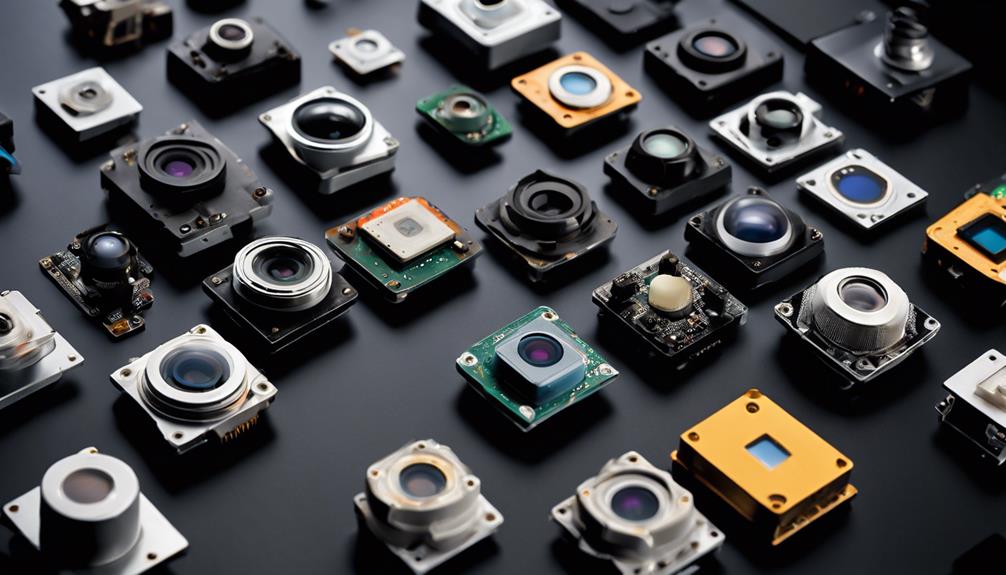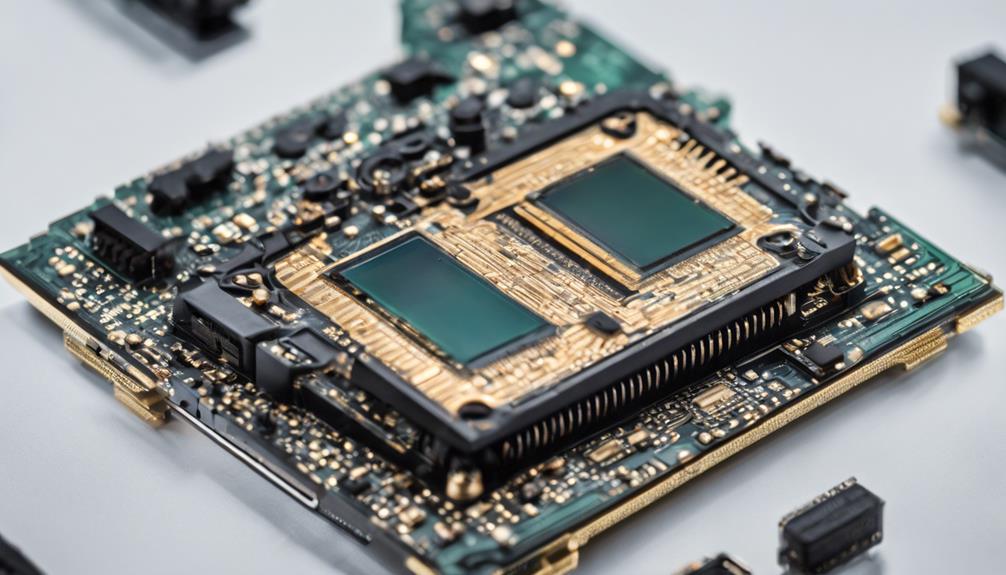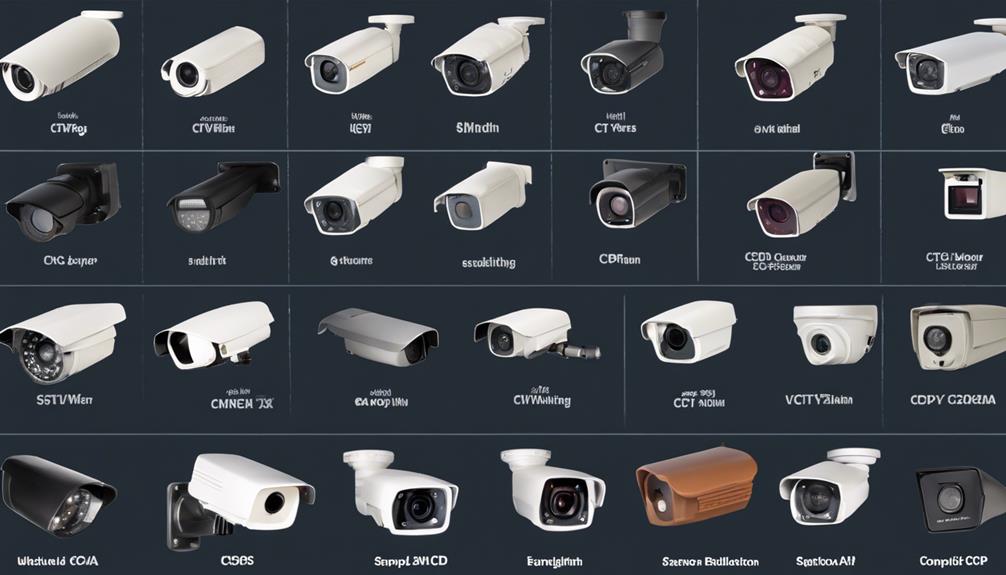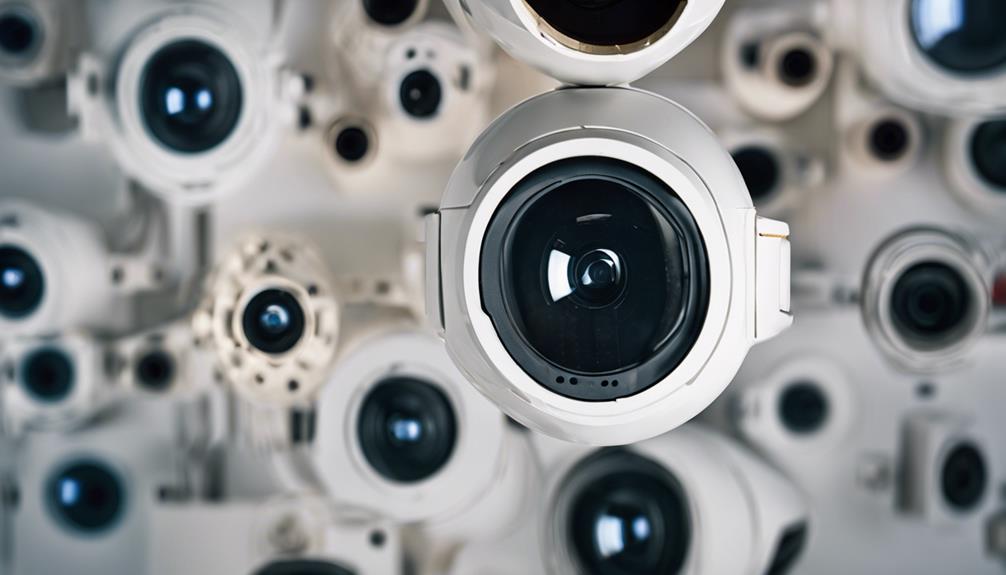When you're examining different CCTV camera sensor types, you'll primarily encounter CCD and CMOS sensors. CCD sensors excel in low-light conditions, producing high-quality images with minimal noise. They're ideal for applications requiring precision, like night surveillance. In contrast, CMOS sensors are more power-efficient and cost-effective, making them suitable for large-scale deployments. Variants like S CMOS and Global Shutter sensors enhance performance in dynamic settings, while infrared sensors capture clear images in darkness by detecting heat. Selecting the right sensor hinges on your specific needs and environmental conditions, so exploring further will uncover essential details for your decision.
Overview of CCTV Sensors

When it comes to CCTV systems, understanding the different sensor types is vital for optimizing surveillance performance. The core of any CCTV setup lies in its sensor technology, which greatly influences image quality, sensitivity, and functionality. You'll encounter various sensor types, each designed to address specific surveillance needs and environmental conditions.
Two primary sensor types dominate the market: CMOS (Complementary Metal-Oxide-Semiconductor) and CCD (Charge-Coupled Device). CMOS sensors are known for their lower power consumption and faster processing capabilities, making them ideal for real-time surveillance innovations. Conversely, CCD sensors often provide superior image quality in low-light situations, though they consume more power.
It's important to assess your specific requirements when selecting a sensor. Factors such as lighting conditions, the area of coverage, and desired image resolution will guide your decision. By grasping the strengths and limitations of these sensor technologies, you can enhance your CCTV system's effectiveness. Ultimately, informed choices empower you to create a surveillance solution that aligns with your need for security and freedom.
CCD Sensors
When evaluating CCD sensors, you'll notice several advantages that make them suitable for specific applications, particularly in low-light environments. Their performance often surpasses that of CMOS sensors with respect to image quality and sensitivity, which is vital in surveillance systems. Understanding these factors will help you determine when to choose CCD technology over alternatives.
Advantages of CCD Sensors
One of the key advantages of CCD (Charge-Coupled Device) sensors is their superior light sensitivity, which results in high-quality images even in low-light conditions. This characteristic makes them particularly appealing for various surveillance applications. Here are three notable benefits:
- Enhanced Image Quality: CCD sensors excel at capturing fine details, leading to clearer images that are essential for identification purposes.
- Low Noise Levels: The architecture of CCD sensors minimizes electronic noise, resulting in cleaner images, especially in darker environments where other sensors might struggle.
- Wide Dynamic Range: CCD technology provides a broader dynamic range, allowing for better performance in scenes with varying light intensities, ensuring that both bright and dark areas are captured effectively.
Common Applications for CCD
CCD sensors are widely utilized in various applications due to their exceptional image quality and sensitivity. One of the most significant areas where you'll find CCD technology is in surveillance systems, particularly in settings requiring high-resolution imaging. Their superior performance in low light conditions makes them ideal for night vision applications, allowing for clear and detailed images even in challenging lighting.
You'll also see CCD sensors in professional video cameras, where capturing high-quality footage is paramount. The low noise levels and high dynamic range of CCD sensors guarantee that images remain clear and vibrant, providing filmmakers with the flexibility they need in diverse environments.
In scientific research, CCD sensors are employed in telescopes and microscopes, where precision is critical. Their ability to capture subtle details in low light enables researchers to gather data that would be otherwise missed with inferior technology.
Moreover, in the medical field, CCD sensors are used in imaging devices, enhancing diagnostics through clearer images. Overall, CCD sensors' versatility across night vision and low-light applications underscores their importance in modern technology, catering to industries where image integrity is non-negotiable.
Comparison With CMOS Sensors
The debate between CCD and CMOS sensors often centers around image quality, power consumption, and cost-effectiveness. When comparing these two types of sensor technology, consider the following factors:
- Image Quality: CCD sensors typically excel in low-light conditions, producing less noise and better dynamic range, which can be essential for surveillance applications.
- Power Consumption: CMOS sensors are generally more power-efficient, allowing for longer operational times on battery-powered devices. This can be a significant advantage in remote installations.
- Cost-Effectiveness: CMOS technology often comes at a lower manufacturing cost, making it more accessible for budget-conscious projects without compromising fundamental functionality.
While CCD sensors deliver superior image quality in challenging lighting, the advantages of CMOS in power efficiency and cost cannot be ignored. If you're prioritizing image quality and detailed imaging, CCD might be the way to go. On the other hand, if you're looking for an efficient, cost-effective solution, CMOS sensors could meet your needs. Ultimately, your choice should align with your specific requirements and constraints, balancing image quality with practicality.
CMOS Sensors
CMOS sensors offer several advantages over CCD sensors, particularly regarding power efficiency and integration capabilities. You'll find that these sensors play a significant role in modern security systems, providing enhanced image processing and lower operational costs. Understanding their specific applications and performance characteristics can help you make informed decisions for your surveillance needs.
Advantages of CMOS Sensors
With their growing popularity in modern surveillance systems, CMOS sensors offer several advantages that make them a preferred choice for many applications. Here are some key benefits you might find appealing:
- Energy Efficiency: CMOS sensors consume considerably less power compared to other technologies, which translates to lower operational costs.
- Cost Effectiveness: The manufacturing process for CMOS sensors is less expensive, making them an economical option for large-scale deployments.
- Design Flexibility: Their compact size allows for versatile designs, enabling integration into various camera forms and functions.
In addition to these advantages, CMOS sensors excel in low light performance and image quality due to ongoing technology advancements. They incorporate effective noise reduction techniques, enhancing image clarity even in challenging conditions. Furthermore, superior heat management capabilities guarantee consistent performance without overheating, further extending the sensor's lifespan.
Comparison With CCD Sensors
When evaluating surveillance technology, a direct comparison between CMOS and CCD sensors reveals distinct differences in performance and application suitability. CMOS sensors generally offer faster readout speeds, enabling higher frame rates, which is essential for capturing fast-moving subjects. This speed can greatly enhance sensor performance, especially in dynamic environments.
In terms of image quality, CCD sensors have traditionally held an edge, particularly in low-light conditions. Their ability to produce less noise results in clearer imagery under challenging lighting. However, advancements in CMOS technology have narrowed this gap, with many modern CMOS sensors delivering comparable low-light performance, thanks to improved noise reduction techniques.
Additionally, CMOS sensors consume less power and are more cost-effective to manufacture, making them a popular choice for various applications. While CCD sensors still excel in certain high-end scenarios, the versatility and efficiency of CMOS sensors make them increasingly favorable.
Ultimately, your choice between these two sensor types should consider your specific needs—whether you prioritize high-speed performance or superior image quality in low-light situations. Understanding these differences empowers you to make informed decisions for your surveillance needs.
Applications in Security Systems
In modern security systems, the integration of CMOS sensors has revolutionized surveillance capabilities, offering a blend of high performance and adaptability. These sensors play a vital role in smart surveillance, enabling you to monitor environments with precision and efficiency. Here are three key applications where CMOS sensors excel:
- Dynamic Range: CMOS sensors adapt well to varying lighting conditions, guaranteeing clarity in both bright and low-light situations.
- Cost-Effectiveness: Their lower power consumption and reduced manufacturing costs make them an attractive option for extensive installations.
- Real-Time Processing: With the ability to process images quickly, they support real-time monitoring, enhancing response times in security incidents.
For peak performance, consider these installation tips: verify proper placement of cameras to maximize coverage, integrate advanced analytics for threat detection, and maintain regular software updates to enhance functionality. By leveraging CMOS sensors in your security systems, you can achieve a more responsive and efficient surveillance setup. Embracing these technologies not only improves safety but also grants you the freedom to monitor your surroundings with confidence and ease.
S CMOS Sensors
S CMOS sensors, or Scanned CMOS sensors, represent a significant advancement in the field of video surveillance technology. Unlike traditional CMOS sensors, these devices utilize a scanning mechanism to capture images, effectively enhancing sensor technology's performance. When you opt for S CMOS sensors, you'll notice an impressive improvement in image quality, particularly in challenging lighting conditions.
The design of S CMOS sensors allows for faster readout speeds, which means you can achieve better motion capture without the distortion often seen in slower sensors. This characteristic is vital for security applications where real-time monitoring is essential. With their ability to minimize noise and improve dynamic range, S CMOS sensors deliver clearer and more detailed images, ensuring that critical details aren't lost.
Moreover, their energy-efficient design contributes to longer operational lifespans, making them a cost-effective choice for extensive surveillance systems. By integrating S CMOS sensors into your security setup, you're not just enhancing image quality; you're also embracing a modern solution that aligns with your need for freedom in surveillance technology. This makes S CMOS sensors a compelling option for those serious about video monitoring efficiency and effectiveness.
Global Shutter Sensors

While S CMOS sensors excel in dynamic range and noise reduction, Global Shutter Sensors offer an alternative approach that addresses motion distortion in video capture. This technology captures an entire frame at once, eliminating the rolling shutter effect often seen in fast-moving scenes. If you're considering global shutter sensors, here are three key benefits:
- Motion Clarity: They provide sharper images of moving subjects, which is essential in security applications where details matter.
- Reduced Distortion: With global shutter technology, there's no skewing or blurring, ensuring accurate representation of fast activities.
- Versatile Use: These sensors are ideal for environments with rapid motion, making them suitable for a range of CCTV applications.
Incorporating global shutter sensor technology into your CCTV system can greatly enhance image quality, particularly in dynamic settings. You'll appreciate the precision these sensors offer, especially when monitoring high-speed scenarios. Overall, global shutter sensors represent a considerable advancement in sensor technology, ensuring you capture the details that matter without compromise.
Infrared Sensors
Infrared sensors play an essential role in enhancing CCTV surveillance, particularly in low-light or nighttime conditions. These sensors allow cameras to capture clear images in darkness, utilizing night vision technology and thermal imaging capabilities. By detecting infrared radiation emitted from objects, they provide visibility where traditional cameras might fail.
| Feature | Night Vision | Thermal Imaging |
|---|---|---|
| Functionality | Amplifies available light | Detects heat signatures |
| Image Clarity | Color images in low light | Monochrome images based on heat |
| Application Areas | Security in dimly lit areas | Search and rescue operations |
| Cost | Generally more affordable | Often more expensive |
The integration of infrared sensors in CCTV systems greatly enhances security measures. They guarantee that surveillance is effective, regardless of lighting conditions, allowing for real-time monitoring and risk assessment. For those seeking freedom in safety, the use of these sensors provides an advanced layer of protection, guaranteeing that every corner is covered, day or night. By choosing infrared technology, you're investing in a robust surveillance solution that adapts to various scenarios.
Choosing the Right Sensor

When selecting a CCTV camera sensor, it's crucial to take into account various factors that align with your specific surveillance needs. The right choice can greatly impact sensor performance and the overall effectiveness of your security system. Here are three key considerations:
- Lighting Conditions: Determine the typical light levels in your installation area. Low-light environments may require sensors with superior sensitivity or infrared capabilities.
- Field of View: Assess the area you want to monitor. A wider field of view may necessitate a higher resolution sensor to capture detail without distortion.
- Environmental Factors: Consider if your camera will be outdoors or indoors. Outdoor installations may need weatherproof sensors to withstand elements.
Once you've evaluated these factors, you can make an informed decision. Remember to follow proper installation tips to guarantee peak performance. Position your camera at the correct height and angle, and make sure it's securely mounted to avoid unnecessary movement. Taking these steps will not only enhance sensor performance but also provide you with the freedom of mind that your surveillance system is functioning effectively.
Frequently Asked Questions
How Do Weather Conditions Affect CCTV Camera Performance?
Weather conditions greatly impact CCTV performance. Rain can blur images, fog creates interference, temperature fluctuations affect clarity, snow accumulates on lenses, high humidity distorts visuals, and wind resistance can shake cameras, degrading overall effectiveness.
Can I Mix Different Sensor Types in My CCTV System?
You might think mixing different sensor types is easy, but sensor compatibility complicates system integration. Each type has unique characteristics, affecting performance. Ensuring they work together seamlessly is essential for achieving ideal surveillance results.
What Is the Lifespan of Different CCTV Camera Sensors?
The lifespan of CCTV camera sensors varies, typically ranging from 5 to 10 years. Regular sensor maintenance and timely upgrades can enhance longevity, ensuring you maintain peak performance while enjoying the freedom of reliable surveillance.
Are There Specific Brands Known for Superior CCTV Sensors?
Superior sensor technology often shines in brands like Sony and Panasonic. In brand comparisons, their commitment to quality guarantees you're investing wisely. Consider durability, clarity, and performance when choosing your ideal CCTV solution.
How Do Lighting Conditions Impact Sensor Effectiveness?
Lighting conditions greatly impact sensor effectiveness. In low light, a sensor's sensitivity is essential; inadequate performance can lead to poor image quality. Choosing a camera with superior low light performance guarantees better visibility in challenging environments.



